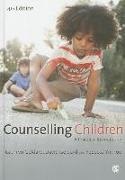Read more
Informationen zum Autor KATHRYN GELDARD, PhD, is a lecturer and counsellor supervisor in the School of Psychology and Counselling at the Queensland University of Technology (QUT) in Brisbane, Australia. Her research interests include adolescent peer counselling and counselling effectiveness as perceived by the adolescent client in the QUT Psychology and Counselling Clinic. Kathryn is currently conducting research with Australian Aboriginal adolescents with regard to developing a culturally sensitive peer support program in a regional community. She is the author of a number of textbooks on counselling and has several years experience in supervising and training counsellors. Klappentext 4th edition, now with a new chapter on ethical considerations, a new chapter covering current research, and new case studies. Zusammenfassung 'In my opinion this really is the definitive document when it comes to working with children therapeutically. The worksheets in the back of the book are excellent and my students make good use of them in their case study work. Highly recommended! ' - Dr Bill Naylor, Development & Society, Sheffield Hallam University Inhaltsverzeichnis PART I: COUNSELLING CHILDREN Goals for Counselling Children The Child-Counsellor Relationship Ethical Considerations when Counselling Children Attributes of a Counsellor for Children PART II: PRACTICE FRAMEWORKS Historical Background and Contemporary Ideas about Counselling Children The Process of Child Therapy The Child's Internal Processes of Therapeutic Change Sequentially Planned Integrative Counselling for Children (the SPICC model) Counselling Children in the Context of Family Therapy Counselling Children in Groups PART III: CHILD COUNSELLING SKILLS Observation Active Listening Helping the Child to Tell Their Story and Get in Touch with Strong Emotions Dealing with Resistance and Transference Dealing with Self-concept and Self-destructive Beliefs Actively Facilitating Change Termination of Counselling Skills for Counselling Children in Groups PART IV: PLAY THERAPY - USE OF MEDIA AND ACTIVITIES The Play Therapy Room The Evidence-base for Play Therapy and Counselling Children Selecting the Appropriate Media or Activity The Use of Miniature Animals Sand-tray Work Working with Clay Drawing, Painting, Collage and Construction The Imaginary Journey Books and Stories Puppets and Soft Toys Imaginative Pretend Play Games PART V: THE USE OF WORKSHEETS Building Self-esteem Social Skills Training Education in Protective Behaviours PART VI: IN CONCLUSION Worksheets Bibliography Index ...

